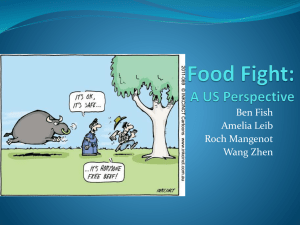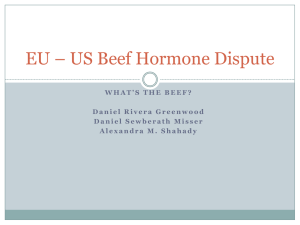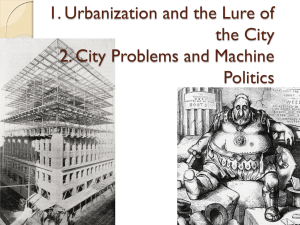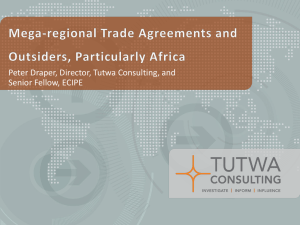Presentation - International Trade Relations
advertisement
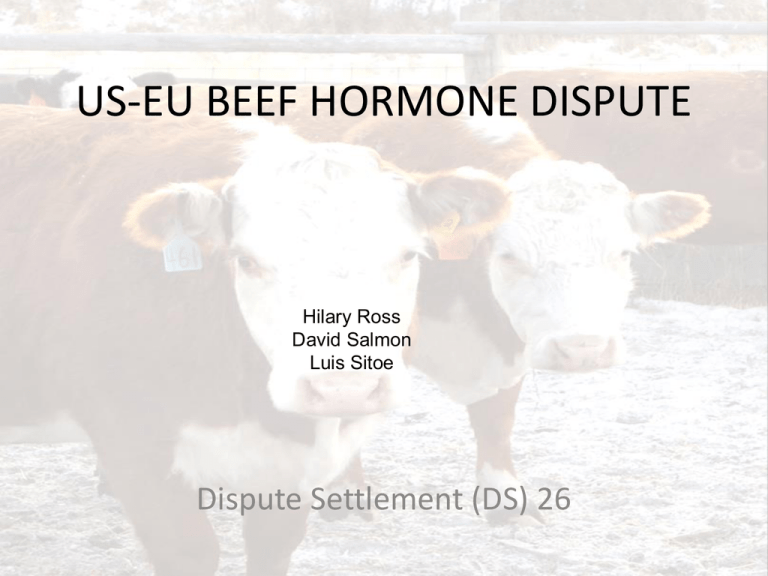
US-EU BEEF HORMONE DISPUTE Hilary Ross David Salmon Luis Sitoe Dispute Settlement (DS) 26 Brief Background • The United States (US) and European Union (EU) are engaged in a long-standing dispute over the EU’s decision to ban hormone-treated beef exports from the US in the EU market – Since 1989, the EU has banned all imports of hormone treated meat into the EU and generally restricts meat imports to a limited quantity of nonhormone treated beef • In 1998, the WTO ruled in favor of the US and the US began retaliatory tariffs of 100% on selected food products, which remain in effect to this day 2 Origin of the Dispute - United States • Growth-enhancing hormones are used widely in beef production in the United States and other meat-exporting countries, such as Australia, Canada, Chile, New Zealand, South Africa and Japan • Hormones are used because they allow animals to grow larger and more quickly on less feed, lowering production costs • In the US, hormones have been approved for use since the 1950’s – Within the US, hormones are now used on approximately 2/3 of all cattle and 90% of cattle on feedlots Origin of the Dispute – EU • Beginning in the early 1980s, the European Union (EU) enacted a full ban on the importation and production of hormone-treated beef • The ban reflects the EU’s approach to food safety, known as the “precautionary principle” of taking “protective action before there is complete scientific proof of risk” US Position • EU rejection of hormone treated beef is merely a protectionist measure disguised as a safety issue • Hormone treated beef is safe – Numerous studies have concluded its safety, EU studies have been inconclusive at best – Many other countries allow for the use of hormone treated beef (Australia, Canada, Chile, Japan, New Zealand, South Africa) • This is a direct violation of the EU’s responsibility under the SPS agreement 5 European Union Position • Hormone treated beef has been linked to carcinogens, thus it has not been proven safe • The EU has the right to ban beef imports under the “precautionary principle” (i.e., the EU may take protective action before there is complete scientific proof of risk) – Must protect the health and safety of EU citizens • The EU has fulfilled its requirements under the SPS agreement 6 US – EU Beef Hormone Dispute Timeline 1981-1996 1981 – EU adopts restrictions on hormone treated beef within the EU 1980 1986 – 1987 US raises EU hormone ban under the Tokyo Round of the GATT Jan 1, 1989 EU enacts a full ban on all hormone treated beef imports 1990 June 1996 – US requests WTO dispute 1995 – panel against the EU, Uruguay claiming EU ban is Round, inconsistent with the including SPS EU’s WTO obligation Agreement under the SPS enters into Agreement effect 2000 7 The Sanitary and Phytosanitary Agreement • Enacted January 1, 1995, as part of Uruguay Round. • Twofold objective: – Respects the right of sovereign WTO members to choose a level of health protection deemed appropriate • Precautionary Principle- countries may protect their citizens against food safety risks before risks are actually scientifically proven. – Ensures that members do not use SPS requirements to enact “unnecessary, arbitrary, scientifically unjustifiable, or disguised” restrictions on international trade. • Allows for food safety and health measure disputes to be settled within the WTO dispute settlement process. SPS Article III • 3.1 – Members should base standards on international guidelines • 5.1 – Members should use the research of international food and health organizations that scientifically study the risk to humans, plants, and animals to develop their own standards • 5.5 – Members may not set or use their standards arbitrarily to discriminate against other Members, and if they are found to have done so they must cooperate in setting reasonable standards US – EU Beef Hormone Dispute Timeline 1996-2009 June 1996 – US requests WTO dispute panel against the EU, claiming EU ban is inconsistent with the EU’s WTO obligation under the SPS Agreement 2003- EU finally publishes studies, claims it is in compliance February 1998 – EU loses appeal but is given 15 months to conduct risk assessment 1995 August 1997- The WTO finds the EU’s ban IS in fact inconsistent with SPS 2008- Panel finds all parties at fault, allows sanctions to continue on all sides 2000 July 1999- US implements sanctions 2010 2004-05- EU requests consultations against US for old sanctions and initiates new proceedings against US and Canada 2009- USTR changes list of EU countries/products affected by sanctions 10 Consultations, Proceedings and Appeals • 1998- EU is still found to be in violation of SPS, but is granted 15 months to prepare a risk assessment of the original hormones in question • EU continues ban on hormones during this time – 1999- Trade concessions in the amount of $116.8 million USD per year and imposes a 100% ad valorem duty on products produced by EU nations, including: – Meat, fish, cheese, tomatoes products, fruit juice, fruits and vegetables, coffee, mustard, soups and broths, toasted breads and cocoa products Consultations, Proceedings and Appeals • In 2003 the EU presents its findings and concludes that it is necessary to ban one hormone permanently and five others provisionally – This supposedly brings the EU into compliance with Article 5.7 of SPS – The provisionary ban might do that, but the fact that the EU still doesn’t use international risk assessment guidelines to set standards does not bring it into compliance with SPS 5.1 Consultations, Proceedings and Appeals • In 2004 the EU calls for new consultations to force the US to remove its sanctions since the EU came back into compliance with the WTO (although it did not remove its ban on any of the hormones) • In 2005 the EU calls for a dispute settlement panel to review the case • In 2008- the panel finds the US and Canada at fault for not removing sanctions, and the EU at fault for not providing enough evidence – Later that year the Appellate Body allows the continuation of trade sanctions on the EU and also the continuation of the ban on beef hormones Consultations, Proceedings and Appeals • 2008- the EU files a new challenge against U.S. and Canadian sanctions, pre-emptively in reaction to. . . . • 2009- the USTR updates the list of EU products , then delays implementation by two months to negotiate a settlement May 2009 Agreement- the end? • On May 13, 2009, the US and EU signed a memorandum of understanding (MOU) to resolve the dispute by increasing market access for US hormone free beef in exchange for a reduction in import duties from EU products into the United States • MOU will be implemented in three phases: • Phase 1: Expand market access for hormone free US beef to a max of 20,000 metric tons • Phase 2: Expand market access for hormone-free US beef to 45, 000 metric tons, contingent on the successful implementation of Phase 1 • Phase 3: Maintain market access for 45,000 metric tons of US beef and US removes import duties of select items under dispute 15 Observations • The ban affected an estimated $100-$200 million in lost U.S. exports –less than one-tenth of one percent of U.S. exports to the EU in 1999; • WTO panels concluded that the EU ban lacked a scientific justification, but the EU refused to remove the ban primarily out of concern that European consumers were opposed to having this kind of meat in the marketplace. Observations (Continued) • The U.S. hard line is buttressed by concerns that other countries might adopt similar measures based on health concerns that lack a legitimate scientific basis according to U.S. standards; • Other U.S. interest groups are concerned that non-compliance by the EU undermines the future ability of the WTO to resolve disputes involving the use of SPS measures Observations (Continued) • WTO disputes involving the United States have resulted in greater market access or more protection of intellectual property rights; • Hormone case showed, a WTO dispute decision against a country does not necessarily result in the timely removal of its trade-restrictive practice; • The losing country may face higher tariffs or pay compensation, neither of which is a goal of dispute settlement; Observations (Continued) • Reform of multilateral dispute settlement procedures to increase the likelihood of compliance: – U.S. proposal for carouselling of retaliation lists • promotes the WTO by strengthening the dispute process, but can undermines the multilateral system through unilateral action; • If not successful, the domestic industry still faces the restrictive foreign market, U.S. consumers of imported goods on the retaliation list have to pay higher prices, and foreign exporters lose sales. • In any case, continuous changes in retaliation lists could hurt some U.S. companies, especially small and medium-sized businesses and importers of items on the lists. – Aggressive monitoring of compliance, particularly for long period of implementation; – Authorization of automatic compensation, and – Remedies for past damage from violations of WTO obligations; US – EU Beef Hormone Dispute Sources • Johnson, Renee and Hanrahan, Charles E. “The U.S. – EU Beef Hormone Dispute”. Congressional Research Service. January 19, 2010. (http://www.loc.gov/crsinfo/whatscrs.html) • Sek, Lenore. “Trade Retaliation: The ‘Carousel Approach’”. Congressional Research Service. March 5, 2002. (http://fpc.state.gov/documents/organization/23368.pdf) • “USTR Announces Agreement With European Union In Beef Hormone Dispute”. Office of the United States Trade Representative. February 24, 2010. (http://www.ustr.gov) • “WTO Hormone Case”. United States Foreign Agricultural Service: Mission to the European Union. August 7, 2007. (http://useu.usmission.gov/agri/ban.html)
